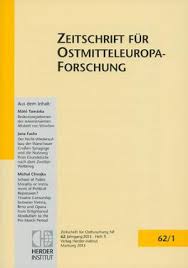Opposition und Samizdat in Ostmitteleuropa. Strukturen und Mechanismen unabhängiger Periodika in vergleichender Perspektive
Opposition and Samizdat in East Central Europe. A Comparative Perspective on Structures and Mechanisms in Independent Periodicals
Author(s): Gregor FeindtSubject(s): Communication studies, Recent History (1900 till today), Politics and communication
Published by: Verlag Herder-Institut
Keywords: Samizdat; East Central Europe; late socialism; comparative history; dissidence; entangled protest; non-conformist communication;
Summary/Abstract: Samizdat, or independent, uncensored journalism, was more than a mere accompaniment to dissent and opposition in late socialist East Central Europe. Samizdat in Poland, Czechoslovakia and Hungary was rather the basic communication forum for opposition actors and the necessary condition for their actions to extend beyond a narrow niche. By disseminating independent and reliable information, the samizdat also served to strengthen community and self-organization among the opposition. This article examines samizdat periodicals in East Central Europe since the mid-1970s, systematizing the culture and structure of underground journalism from a comparative perspective. An affirmative awareness of oppositional pluralism from the very first years of samizdat enabled their self-understanding as a forum for various political and programmatic positions. Significant differences between the three countries can be seen in the way samizdat was produced. This was collaborative throughout, but only in Poland did it extend to quasi-oppositional presses with four-figure print runs. What guaranteed the samizdat’s success was its reception, which remained mostly limited to the metropolitan cities and only in Poland reached the entire country, even including rural areas. It is also possible to identify numerous links and exchanges between samizdat actors in Poland, Czechoslovakia and Hungary, which extended to close contact with Western supporters and various exile publications. Thus the different journal formats were not only based on common models, but technical knowledge and organizational forms also crossed borders. Samizdat in late socialist East Central Europe, like the broader opposition itself, can be understood as a transnational phenomenon. This contribution details how the samizdat, despite all its qualitative differences in the various countries of East Central Europe, was not separated from each other, but mainly differed in its different distribution and the associated structural development of its success. The Polish case in particular shows that such success could also call into question the samizdat’s very intentions, if by achieving such an extensive presence it lost the attraction of independent information. These findings demonstrate how the samizdat— understood as a culture and a structure—can be a meta-source for the history of dissidence and opposition in East Central Europe.
Journal: Zeitschrift für Ostmitteleuropa-Forschung
- Issue Year: 65/2016
- Issue No: 1
- Page Range: 17-42
- Page Count: 26
- Language: German

